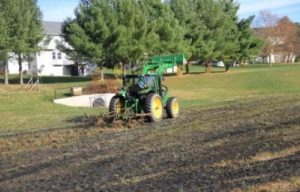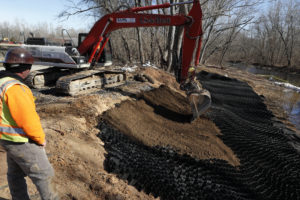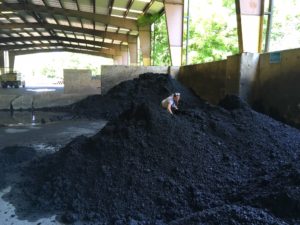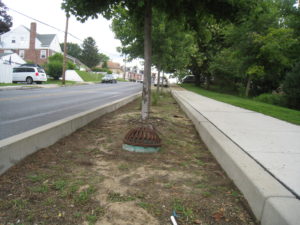Vitamins and minerals make us healthy and strong. We’d also like our stormwater practices to be healthy and strong, but they may need some over-the-counter supplements to boost their performance and vitality. Nobody wants a listless BMP in need of a mood adjustment.
Our profession has been continuously improving BMP materials and specifications as we learn lessons from research and practice. What additional innovations may be on the horizon? This article covers just a few types of materials that are slowly (but perhaps inevitably) entering the BMP landscape.
Biochar
Some would consider Biochar as a “superfood” for stormwater. This exotic-sounding material is really just a burned up carbon source, but not by any ordinary campfire. The process if called pyrolysis, and involves combustion at extreme heat with little or no oxygen. The briquettes on your backyard barbecue are not too far off the mark.
Source materials for biochar can include various types of biomass: wood chips, poultry litter, switchgrass, and waste wood products, among other sources. The resulting material has a very porous and reactive surface area, which is available to bind up all kinds of potential pollutants, including metals and nutrients. Biochar bonding seems to have a very long shelf-life. Laboratory studies indicate many years of good sequestration for various pollutants. Biochar also appears to boost the water retention capacity of soil, which could enhance runoff reduction benefits.
For stormwater, you may want to stay away from biochar derived from animal waste (e.g., poultry litter), as nutrients concentrations may be high, creating a potential leaching issue. Wood-based biochars are the better option.
Environmental applications have included tilling biochar into the bottom of an existing detention pond as part of a retrofit, using biochar-filled geoweb on streambanks to remediate heavy metal contamination, mixing biochar into roadside shoulder soils to retain more water, and even deploying biochar “pillows” in reservoirs or lakes suffering from eutrophication.
The key stormwater questions for biochar are what sources are available and how much does the material cost (purchasing, transporting, mixing)? It seems to be growing industry, and websites such as the U.S. Biochar Initiative may be of some help (but may not have all the regional and/or smaller-scale sources). It would be helpful to ask colleagues who have some experience with the material.
Left: biochar being tilled into the bottom of a detention pond as part of a retrofit (photo credit: Bryan Seipp, Center for Watershed Protection). Right: biochar used to fill geoweb on a streambank to help remediate mercury contamination (photo credit: Mark Miller Photography). For the latter, the remedy was deployed after several years of biochar testing to gage its effectiveness. For more information, see: http://southriverscienceteam.org/.
Water Treatment Residuals (WTRs)
It just might be that your municipal drinking water treatment process produces a by-product that could help improve stormwater management. That nice, clear drinking water achieves its clarity through a settling process using flocculants. The flocculants settle out the solids derived from the raw water source, and the settled materials are known as Water Treatment Residuals (WTRs). As a residual product, most treatment plants must figure out how to get rid of the WTRs, mostly by hauling them off-site for other uses, such as land application or disposal. But the WTRs may have some benefit in the stormwater arena?
Most drinking water treatment plants use flocculants that contain Aluminum. The Aluminum is very good at binding up soil particles, which allows for the desired settling. As it turns out, Aluminum is also very good at binding up Phosphorus, especially in its dissolved forms (e.g., Phosphate). Recent stormwater research indicates that many of our BMPs do a great job of removing the particulate forms of pollutants, but a sizable percentage of the dissolved fraction can whistle right through to the receiving waters. This is not good for downstream waterbodies, as the dissolved forms are the most bio-available to potentially create excessive algae growth and dissolved oxygen issues.
Several researchers have been using Aluminum-containing WTRs to see if they can chase down more of the dissolved Phosphorus. The research looks promising, and almost every community has a drinking water treatment plants. So, is adding WTRs to stormwater soil media a no-brainer?
It may (or may not) be, as there is still work to do before this type of process can be scaled-up for broader applications beyond the limited research that has been conducted. Issues such as material testing, drying and mixing, and procuring the WTRs in safe and legal ways still need some proof-of-concept. After a drying process in a belt press or centrifuge, WTRs have the consistency of Play Dough ®, and, as they dry further, form hardened bricks (or clods) of various sizes. Additional investigation is needed on proper drying, busting up the clods, and mixing with the other components of bioretention soil media.
It should also be noted that by-products containing Iron can also perform a similar function, and some stormwater research facilities, such as St. Anthony Falls Laboratory at the University of Minnesota, have been piloting several interesting Iron-enhanced BMPs.
Left: WTRs at a water treatment plant being loaded for off-site use. Right: After drying in a belt press or centrifuge, WTRs have a Play Dough ® consistency but are dry enough to be hauled off-site.
I did a WTR drying experiment on my front porch with WTRs from a couple of different sources. This highly scientific study indicates that the material is pretty dry after 3 days of air-drying and forms hardened clods of various sizes, but these can be broken up with a little agitation.
Vegetation
We have all seen bioretention and other vegetated practices where the BIO part may be lacking. In other words, the plants are either missing, dying, or replaced by vast seas of mulch. These issues can result from the original design, installation, and especially long-term maintenance. We know now, supported by research, that the vegetation is a critical component of a well-performing system, equal or exceeding in importance compared to the soil media and other system components.
We all know about vegetation, but getting it right in a stormwater practice is deceptively difficult. This requires not just good design, but ongoing attention during establishment and through various phases of adaptive management. However, in the long-run, a well-functioning vegetative system could be the most productive pollutant processing machine we have available. This system contains both above-ground and below-ground biomass. The below ground microbial community associated with plant roots plays a key role in immobilizing dissolved nutrients during the wet and dry cycles encountered in stormwater practices. As plants mature, their root systems maintain or even increase the hydraulic conductivity of the media and the practice as a whole.
This is truly boot camp for BMPs: get the vegetation right! Of course, this requires a suitable soil media recipe (plenty of vitamins and minerals!) and a good deal of care during establishment. On all of these scores, we are still on the learning curve.
The difference between poor and robust vegetation in a BMP is more than just an aesthetic issue. Vegetation plays a key role in pollutant processing due to both above-ground and below-ground biomass.
Unproven Supplements
As with over-the-counter supplements for your health, there is a wide diversity of other materials that have been tested for water treatment. A short list includes: limestone, gypsum, fly ash, steel slag, acid mine drainage residuals, zeolite, metal-coated sand, calcareous sand, peat, sawdust, tire chips, soybean hulls, crab shells, shell sand, pumice soil, tephra, and mushroom mycelium.
Some of these are not “prescribed” for stormwater applications (e.g., limestone). For the others, let’s just say I’ll continue to take my probiotic, chia seeds, and hemp oil, and see where the research leads us next on the stormwater front.
Resources & Acknowledgements
Information in this article was derived from several projects I participated in with the Chesapeake Stormwater Network and Center for Watershed Protection through various funding sources, including the National Fish & Wildlife Foundation and Chesapeake Bay Trust. This work was conducted under the banner of “Performance Enhancing Devices for BMPs.” The resources below include a PEDs literature review as well as fact sheets for various PEDs that are more in the format of specifications.
I am grateful for the opportunity to work on these interesting projects, and wish to acknowledge colleagues at CSN and CWP for their collaboration, assistance, and guidance, as well as the various funding agencies.
Literature Review
Performance Enhancing Devices for Stormwater Best Management Practice
PEDs Fact Sheets:
Biochar_122418
Water Treatment Residuals_011519
Iron Amendments_122418 (Andy Erickson)
Vegetation_122418
See also my Projects page for more information.







